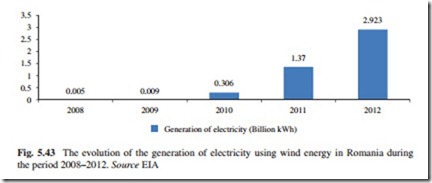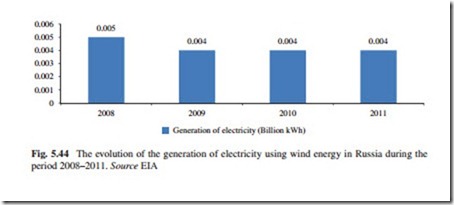The Russian Federation (Russia)
In 1931, the first utility-scale wind turbine was developed in Russia. The 100-kW Balaclava wind generator operated for two years along the Caspian Sea. After this first attempt to develop wind power in Russia, no more wind turbine was installed in the country. At the moment, there are few wind plants in operation, despite the fact that the country has the highest wind potential in the world (10.7 GW). Russia has many locations with favorable conditions for the use of wind energy. The regions with the highest wind potential are the coastlines of the Pacific and Arctic Oceans, the Caucasus region, the Urals region, and the Altai and the Sayan Mountains. Currently, the largest wind farms are located in the Kaliningrad region, Republic of Bashkortostan, Republic of Kalmykia, and in Chukotka.
At present, and without regulatory framework or support scheme for renewables, Russian wind sector is underdeveloped, but now in a state of reconstruction and development due to measures adopted by the government to support the use of renewables for electricity generation. However, and despite the measures adopted by the Russian government, it is important to highlight that only Western companies dominate the market of wind power equipment.
There are several reasons why the use of renewable energy in Russia is still far behind Europe. First and foremost, it is so because of the low cost of traditional and locally available energy sources. Russia is in possession of huge oil and gas reserves, which are easily accessible and make the production of fuel and energy very cheap. In order to keep the energy prices on the Russian market low, the government imposes high export duties on all commodities. Russian officials have explained occasionally that they consider the huge energy reserves and consequently low energy prices to be a sort of compensation for the substantial disadvantages Russian businesses encounter, because of the severity of its climate and the remoteness of its locations. The rise of energy prices would not only cause significant hardship to many families, which are already struggling to make ends meet, but would also lead to numerous dis- missals. Many plants, especially in the metallurgical field, would have to close down, because their main asset, the low energy prices, would be void. It goes without saying that the Russian government perfectly understands these causalities and will certainly not raise the prices substantially, fearing social unrest (Bächtold 2012).
At the same time, it is hard to find any Russian technology available yet in the wind sector. Since the Russian wind energy sector is underdeveloped, modern wind turbines with capacity higher than 1 MW are not produced in Russia. Moreover, there is a limited local supply chain, as domestic companies do not have experience in manufacturing components for modern wind turbines or in building and servicing wind farms.
Despite the above, wind energy is the most dynamically developing renewable energy sector in Russia. During the recent years, it has surpassed even hydropower
in terms of numbers of newly installed power facilities. After the closure of RAO- EES, Rushydro now also manages the development of the sector and the main wind park projects (Abercade 2010). The country has excellent potential for wind power generation. An attempt to utilize just 25 % of its total potential would yield some 175,000 MW of power.
In order to promote the use of wind power for the generation of electricity, the country is to invest US$200 million in the construction of the country’s largest wind farm (Yeisk) in the Black Sea Territory of Southern Krasnodar. The wind farm has a total capacity of 100 MW. However, construction is dependent on a bill that strategizes the funding procedure; this is yet to be released, and consequently, the farm is not expected to come online until 2014 (Russia’s Renewable Report Q4 2012).
In 2012, there were 10 large wind farms in Russia and 1,600 small wind farms with a capacity ranging from 0.1 to 30 kW each. Majority of those large wind farms have been installed within 2002–2003. During the following years, mainly small-scale wind systems have been installed—only 250 wind turbines with capacity ranging from 1 kW and up to 5 kW. At the end of 2013, a total of 17 MW of wind power capacity was installed in the country, which represents an increase of 9.1 % with respect to 2012.21 In 2014, a total of 13 wind power installations will start generating power in Kalmykia. The major increase in the wind power capacity in the country in the past 12 years was reached in 2005 (27.3 %).
According to government sources, up to 16 new wind farms will be built in Russia by 2030. The wind farms will be built in each region of the country. In case of the Southern Federal District, five large wind power projects are planned. Among these are the 100-MW Astrakhan wind farm and the 999-MW Volgograd Lower Volga project, both of which are expected to be commissioned by 2030. Two wind farms are also planned in the Kalmykia Republic of Russia, which will have the capacity of 150 and 300 MW and will be launched by 2025. A further two projects, dubbed Lodeyny and Kolsky, will be built in the Murmansk region and will have a capacity of 300 and 500 MW, respectively. Finally, a 300-MW project is planned for Ust-Luga, St. Petersburg region and a 200-MW wind farm is to be built in the Kaliningrad region.
There are around 50 companies on the wind energy equipment market in Russia in 2012. About 20 companies are equipment and turbine manufacturers; 13 companies are located in the Central Federal District. Domestic manufacturers mostly produce turbines between 100 and 250 kW. On average, there are four types of turbines offered on the Russian market. Most competitive segments of turbine production are found in the range between 1 and 15 kW.
Nowadays, the amount of energy generated by renewable energy sources in Russia is 8.5 billion kWh, which is less than 1 % of the total amount (this figure does not include hydropower generation exceeding 25 MW).
In May 2013, the Russian government has passed several normative acts, which stimulate investments in renewable energy sources. For instance, the Decree 449 “Renewable Energy Source Development Measures” aims to develop and support In order to reach the projected wind power capacity, Russia’s first renewable energy auction took place in September 2013. While it did not result in a big allocation to solar and wind, it was the first practical test for the effectiveness of the support scheme and provided important learnings. Out of the 1,100 MW of wind power on offer, only 110 MW were applied for and awarded. The rigid local con- tent stipulation was a key issue preventing a greater share, especially for wind— wind projects must source 55 % of equipment from local suppliers by 2015, rising to 65 % after 2016.
As wind power is essentially a new industry and equipment has not been produced commercially in Russia before, local content requirements are currently difficult to meet. The Russian Association of Wind Power Industry estimates that at the time of the first auction, only 53 % of the equipment, such as towers and main shafts, could be sourced locally, which is less than the required 55 %. A higher share would first require a ramp-up of particular production capacities—a challenge that will arguably mitigate with time and the entry of more Russian companies into the wind business.
Generation of Electricity Using Wind Energy
The evolution of the generation of electricity using wind energy in Russia during the period 2008–2011 is shown in Fig. 5.44.
According to Fig. 5.44, the generation of electricity in Russia using wind energy during the period 2008–2011 decreased 20 %, although the level of the generation of electricity stays the same in the last three years of the period considered. It is expected that the generation of electricity in the country using this type of energy source will continue to increase during the coming years, but in a slow rate.


